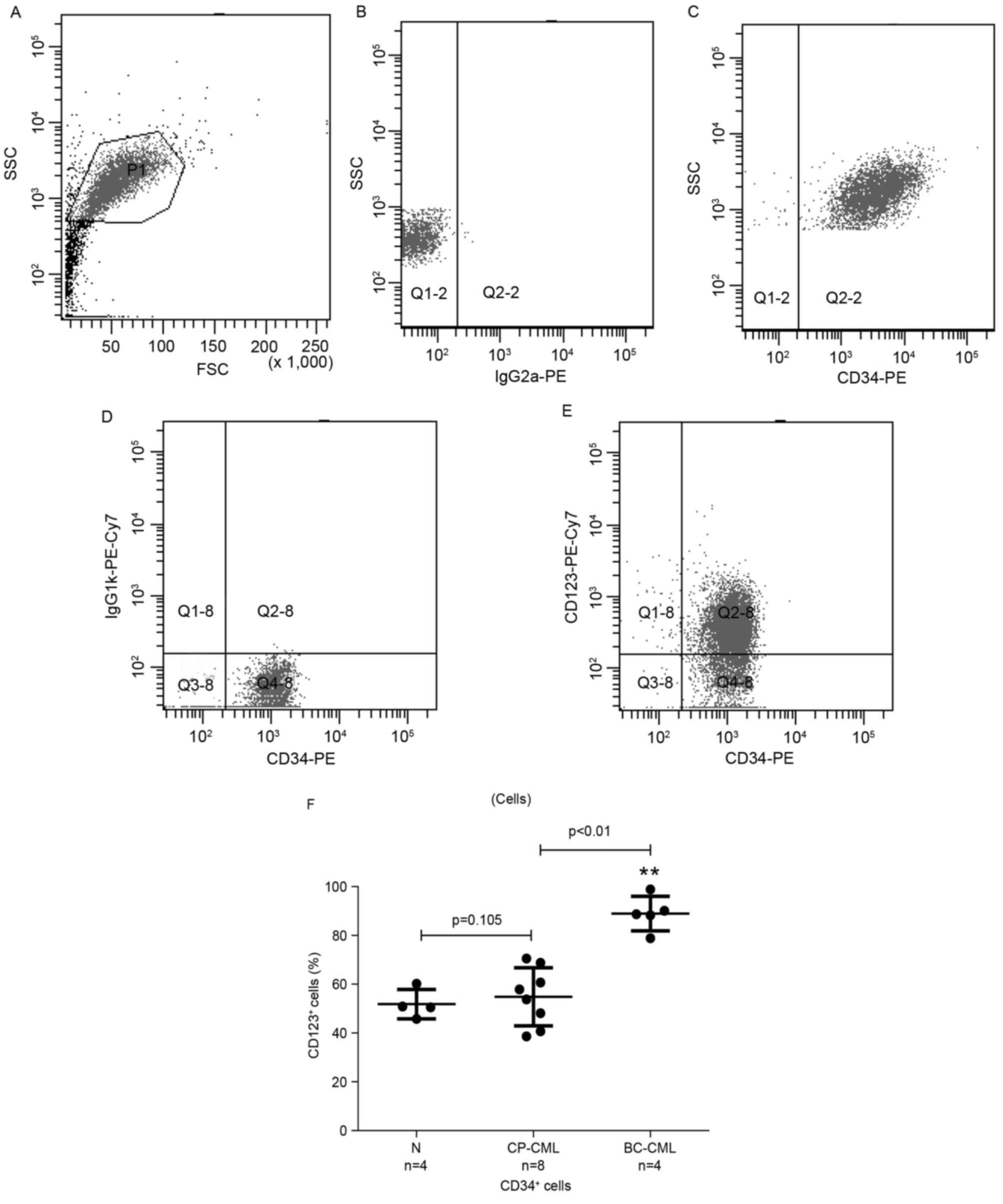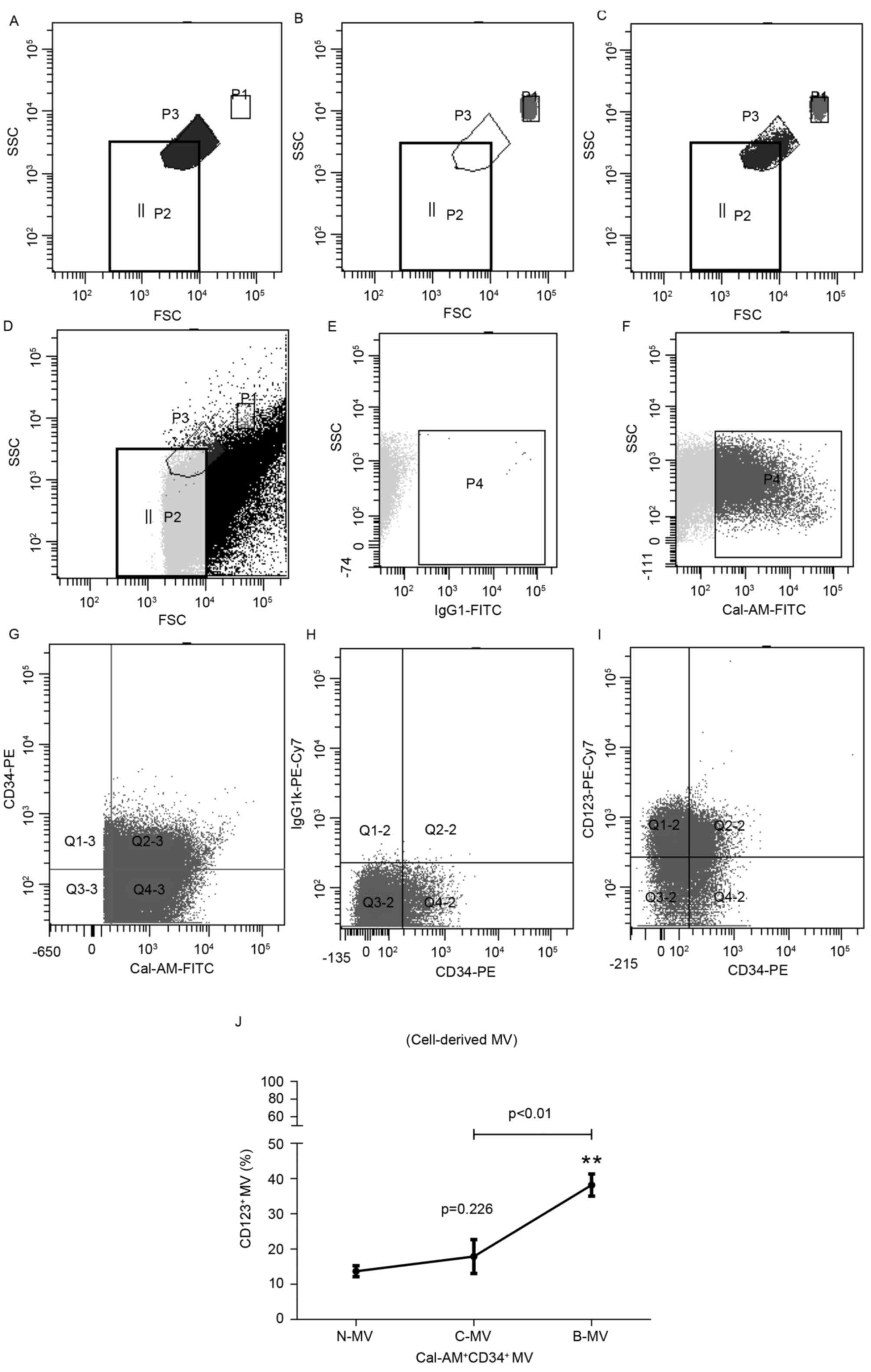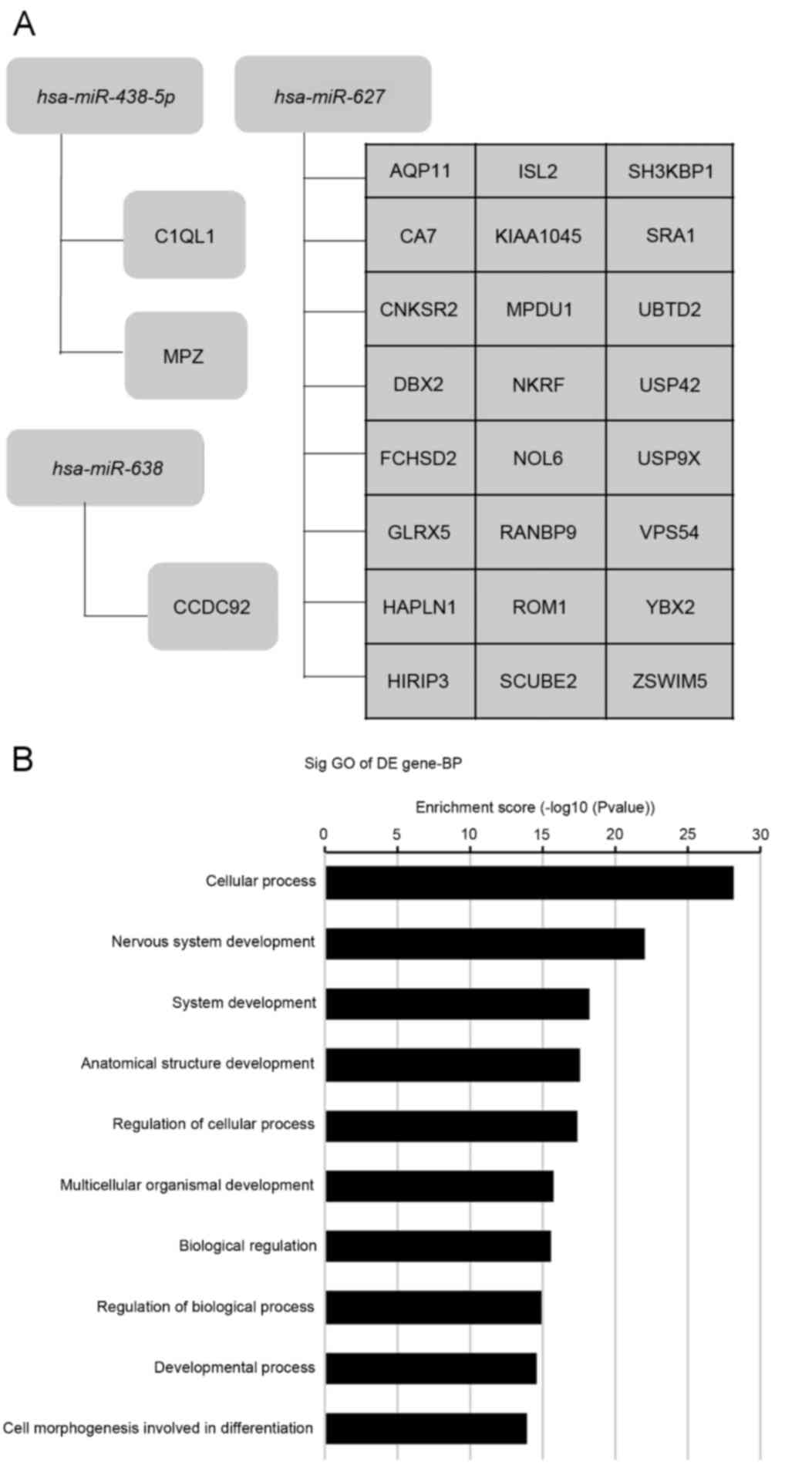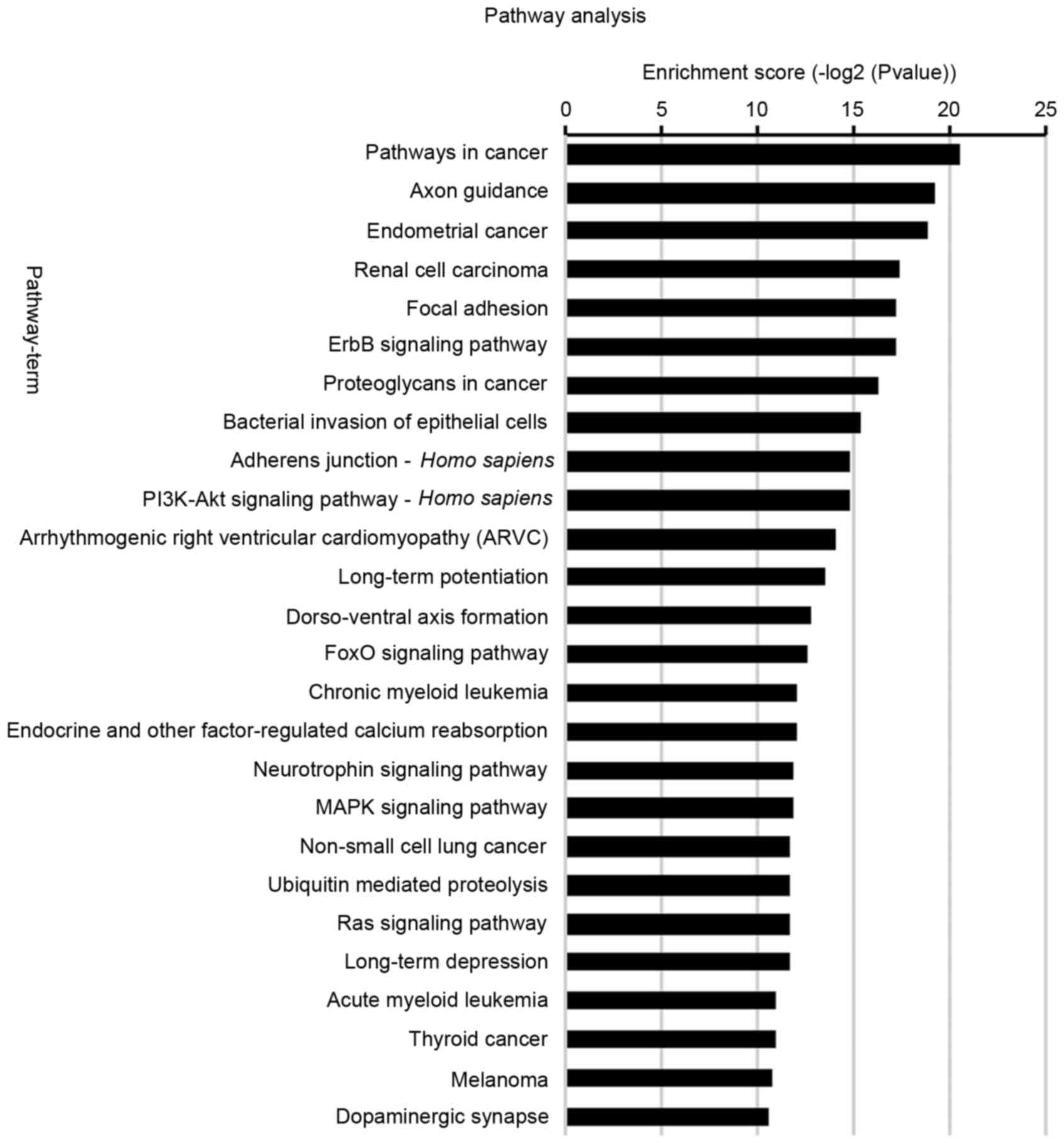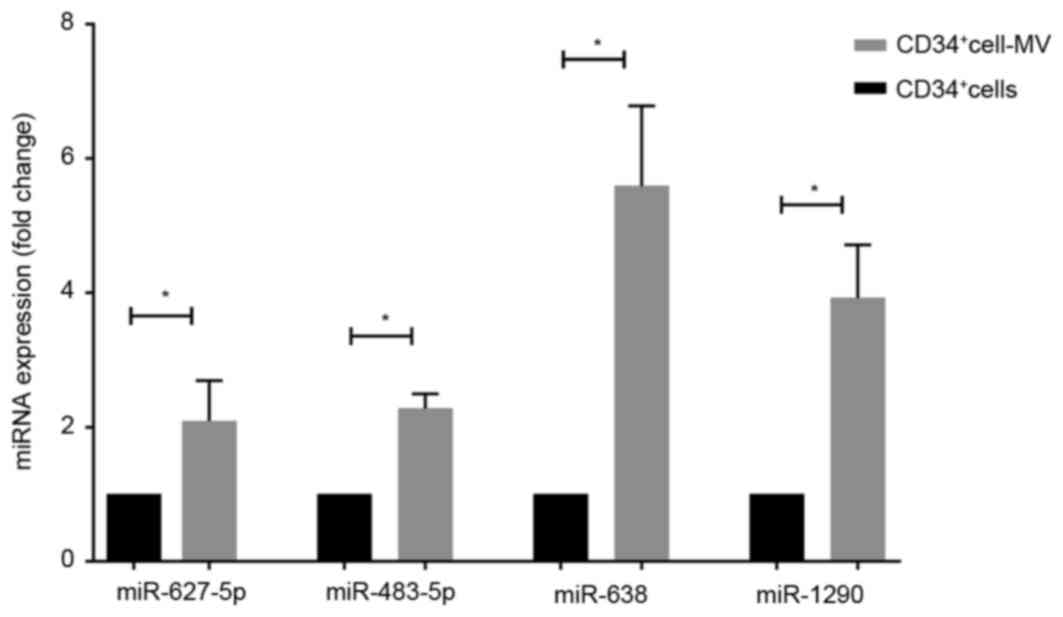Selective surface marker and miRNA profiles of CD34+ blast-derived microvesicles in chronic myelogenous leukemia
- Authors:
- Published online on: June 7, 2017 https://doi.org/10.3892/ol.2017.6336
- Pages: 1866-1874
Abstract
Introduction
Chronic myelogenous leukemia (CML) is a clonal myeloproliferative disorder that is derived from abnormal pluripotent bone marrow hematopoietic stem cells, characterized by the Philadelphia chromosome and/or the breakpoint cluster region protein (BCR)-Abelson murine leukemia viral oncogene homolog 1 (ABL) fusion gene (1). Imatinib (Gleevec), a small-molecule BCR-ABL tyrosine kinase inhibitor (TKI), markedly improved the estimated overall survival rate in patients with chronic-phase (CP)-CML to between 80 and 85% at 7–10 years (2,3). However, although imatinib eradicated mature BCR-ABL+ CML cells, it was not able to achieve similar effects in CML leukemia stem cells (LSCs) since BCR-ABL tyrosine kinase is dispensable for CML LSC survival and maintenance, rendering these cells able to survive in the presence of TKIs and to eventually promote relapse (4,5). Therefore, the elucidation of the biological characteristics of the LSC is required.
Microvesicles (MVs), lipid-bilayer vesicles formed by directly budding off from the cell membrane, represent a heterogeneous population of vesicles with a diameter of between 100 and 1,000 nm (6,7). MVs are able to selectively package complex biological information from parental cells, including mRNA, microRNA (miRNA) and proteins, which serve an important role in intercellular communication (8). Previous studies have suggested that MVs are involved in inflammation, immune regulation, tumor metastasis and angiogenesis, and may also be indicators for the diagnosis and prognosis of disease (9–12).
miRNAs, a large family of small (between 22 and 24 nucleotides in length) non-coding RNAs, decrease gene expression levels by regulating the translation of certain mRNAs into protein and serve an important role in disease progression and carcinogenesis. An increasing number of studies have revealed that genetic exchange of miRNA between cells may be accomplished through MVs (13). For instance, MVs derived from endothelial progenitor cells protect the kidneys from acute ischemic injury by miRNA-dependent reprogramming of resident renal cells (14). Additionally, embryonic stem cell-derived MVs may be useful therapeutic tools for transferring miRNA to cells and important mediators of signaling within stem cell niches (15). Although a number of cell-derived MVs are currently recognized and studied, MVs derived from primary CML LSCs remain unknown, and there is a lack of comprehensive information concerning miRNA from LSC-secreted MVs.
In the present study, CML LSCs were studied and MVs secreted from LSCs were characterized in terms of surface markers and miRNA profiles. Furthermore, the miRNA profiles in MVs of CML blasts were compared with those of the AML stem cell line KG-1a. The results of the present study revealed that these miRNAs were primarily associated with MVs and stem cells, and may affect characteristics of LSCs.
Materials and methods
Patient samples
Fresh peripheral blood (PB) or bone marrow (BM) samples were obtained from healthy donors and patients with CML (patient characteristics are listed in Table I). PB cells were also acquired from leftover material from PB transplant harvests of healthy donors. Written informed consent was obtained and the present study was approved by the Ethics Committee of Union Hospital, Tongji Medical College, Huazhong University of Science and Technology (Wuhan, China). Mononuclear cells were extracted by Ficoll-Paque density gradient centrifugation (Lymphoprep™, 1.073 g/ml; Tianjinhaoyang Biological Manufacture Co., Ltd, Tianjin, China) according to the manufacturer's protocol.
Cluster of differentiation (CD)34+ cell isolation and cell culture. CD34+ cells (>92% pure) were isolated using immunomagnetic separation by positive selection of cells (human CD34 microbead kit; Miltenyi Biotec GmbH, Bergisch Gladbach, Germany), according to the manufacturer's protocol. Primary CD34+ cells were cultured in StemSpan serum-free medium (Stemcell Technologies, Inc., Vancouver, BC, Canada) which was supplemented with a growth factor mixture, including 100 ng/ml each of Fms-related tyrosine kinase-3 ligand and stem cell factor, and 20 ng/ml each of interleukin (IL)-3, IL-6 and granulocyte-colony stimulating factor (Peprotech, Inc., Rocky Hill, NJ, USA). Primary cells were counted using a hemocytometer and subsequently cultured at density of 5×104 cells/ml. After 48 h, cells were collected for flow cytometry or miRNA experiments and culture medium was used for MV isolation. The KG-1a cells, a human acute myelogenous leukemia (AML) cell line, were stored long-term and passaged in the Institute of Hematology, Union Hospital, Tongji Medical College, Huazhong University of Science and Technology (Wuhan, China). The KG-1a cell line, with ~95% CD34 expression, was routinely cultured in RPMI-1640 medium (Gibco; Thermo Fisher Scientific, Inc., Waltham, MA, USA) and supplemented with 10% fetal bovine serum (FBS); FBS-derived MVs were removed using a differential centrifugation method, including 750 × g for 15 min, followed by 1,500 × g for 20 min and then 16,000 × g for 45 min, at 4°C. The cells were cultured at 37°C in a humidified atmosphere containing 5% CO2. The culture medium was collected and replaced with fresh medium every 48 h.
Preparation of MVs
MVs were isolated from the conditioned medium of CD34+ cells and KG-1a cells by continuous differential centrifugation as described previously (9). At the time of culture medium harvest, MVs were prepared by differential centrifugation as described in the previous section. Pellets of MVs were washed in ice-cold PBS (particles <0.1 µm were removed with a membrane filter prior to use) for flow cytometric analysis.
Flow cytometric analysis
To analyze CD123 expression, CD34+ cells were stained with anti-CD34-phycoerythrin (PE) antibody (1:50; cat. no., 130-098-140; Miltenyi Biotec GmbH) and anti-CD123-PE-cyanine 7 antibody (1:50; cat. no., 306009; BioLegend, Inc., San Diego, CA, USA) per tube. A previously described method (16) was utilized to analyze the phenotype of MVs. In brief, standard microbeads with a diameter of 1 or 3 µm (Sigma-Aldrich; Merck KGaA, Darmstadt, Germany) were used to set the upper size limit for MVs. MVs isolated from a 10 ml supernatant of CD34+ cell-conditioned medium were resuspended in PBS (extra particles with 0.1 µm membrane filter were removed prior to use) and then stained with calcein-acetoxymethyl ester (AM) (5 µg/ml; cat. no., 65-0853-39; Thermo Fisher Scientific, Inc.), CD34 and CD123 for 20 min at ambient temperature. The stained MVs were diluted in 300 µl PBS and analyzed using a FACSAria II flow cytometer with FACSDiva version 6.1.3 software (BD Pharmingen, San Diego, CA, USA). MVs were defined as calcein-AM-positive events.
miRNA expression profiling
miRNA expression profiles were conducted on 4 samples [CP-CML CD34+ cells (C-C); CP-CML CD34+ cell-derived MVs (C-MV); KG-1a cells (K-C); KG-1a cell-derived MVs (K-MV)] using miRCURY™ locked nucleic acid (LNA) array (7th generation, version 18.0; Exiqon A/S, Vedbaek, Denmark) containing probes for 3,100 miRNAs. Total RNA was isolated using TRIzol (Thermo Fisher Scientific, Inc.) and purified using an RNeasy mini kit (Qiagen GmbH, Hilden, Germany) according to the manufacturer's protocol. RNA was quantified using a NanoDrop spectrophotometer (ND-1000; NanoDrop Technologies; Thermo Fisher Scientific, Inc.) and RNA integrity was determined by gel electrophoresis. Following RNA extraction from the samples, miRNAs were labelled using the miRCURY™ Hy3™/Hy5™ Power Labeling kit (Exiqon A/S), according to the manufacturer's protocol. Subsequently, the Hy3™-labeled samples were hybridized on the miRCURY™ LNA array. Following hybridization, the slides were washed five times with the Wash Buffer kit (Exiqon A/S) and dried by centrifugation at 200 × g for 5 min. The slides were scanned using the Axon GenePix 4000B microarray scanner (Axon Instruments; Molecular Devices, LLC, Sunnyvale, CA, USA). Scanned images were then imported into GenePix Pro 6.0 software (Axon Instruments; Molecular Devices, LLC) for grid alignment and data extraction. The 4 replicated spots for each probe were averaged. Expressed results were normalized using the median normalization method (foreground-background signal intensity)/median of samples with intensity ≥30) and subsequently identified differentially expressed (DE) miRNAs between two samples were filtered by fold change (threshold, ≥2.0).
Validation of microarray results
A total of 4 DE miRNAs identified by miRNA microarray were selected for further validation by reverse transcription-quantitative polymerase chain reaction (RT-qPCR). RNA (400 ng) was reverse transcribed with a reaction mix of of dNTPs (HyTest Ltd., Turku, Finland), RT buffer, MMLV reverse transcriptase, RNase inhibitor (all from Epicentre; Illumina, Inc., San Diego, CA, USA), specific primers (Balige Co., Shanghai, China) and RNAase-free water to 20 µl. The reaction was performed at 16°C for 30 min, followed by a 40-min incubation at 42°C and finally 85°C for 5 min using an Applied Biosystems 9700 Real-Time PCR instrument (Thermo Fisher Scientific, Inc.).
SYBR Green miRNA assays with commercially available primers (Table II) for hsa-miR-627-5p, hsa-miR-483-5p, hsa-miR-638 and hsa-miR-1290 (all materials from Guangzhou RiboBio Co., Ltd., Guangzhou, China) were used according to the manufacturer's protocol. Relative expression was calculated with the 2−∆∆Cq method with an Applied Biosystems ViiA 7 Real-Time PCR system (Thermo Fisher Scientific, Inc.) (17).
Target gene prediction
TargetScan, miRBase and miRanda databases were used to predict the target genes of DE miRNAs. Among the putative targets, the overlapping genes from these databases were determined.
Bioinformatics and statistical analysis
Gene Ontology (GO) analysis and pathway annotation were used to examine the gene pool of DE miRNAs. GO terms were analyzed using the GO database. Fisher's exact test was used to identify any overlap between the DE list and the GO annotation list greater than was expected by chance. The P-value denoted the statistical significance of GO term enrichment in the DE genes. Pathway analysis is a functional analysis mapping genes to Kyoto Encyclopedia of Genes and Genomes (KEGG) pathways. The P-value denoted the statistical significance of the pathway associated with the conditions. P<0.05 was considered to indicate a statistically significant difference.
Results
CML CD34+ blasts and blast-derived-MVs express increased levels of CD123
A previous study demonstrated that IL-3 receptor α (CD123) expression is elevated in CML progenitor and stem cells compared with healthy donors (18), which led to the collection of samples from 4 patients with blast crisis (BC)-CML, 8 patients with CP-CML and 4 cases of healthy donor stem cell residue in the present study. Multicolor flow cytometry was used to determine the surface marker profile of CML CD34+ cells and cell-derived MVs. The results of the present study indicated that, compared with healthy CD34+ cell samples, CD123 expression levels of BC-CML CD34+ cells were significantly increased. There was also a marked difference between BC-CML and CP-CML CD34+ cells, as presented in Fig. 1: Compared with MVs from healthy CD34+ samples, CD123 expression levels of BC-CML CD34+ cell-derived MVs were significantly increased, whereas expression levels of CP-CML CD34+ cell-derived MVs slightly increased. As presented in Fig. 2, BC-CML and CP-CML CD34+ cell-derived MVs also demonstrated significant differences. The results of the present study revealed that the expression levels of CD123 in CD34+ cells and MVs gradually increased in association with disease progression.
Comparison of MV-derived and cell-derived miRNA profiles
To validate the hypothesis that miRNAs in the MVs enabled communication and reflected genetic changes within LSCs, miRNA profiles of the MVs extracted from CML CD34+ blast cells and KG-1a were determined. It was hypothesized that there were differences in the miRNA expression levels between MVs and LSCs, therefore the RNA of CML blasts and KG-1a cells was also extracted and hybridized (CML CD34+ blast cells, CML blast-derived MV, KG-1a cells and KG-1a-derived MV, n=2). Each sample was analyzed in duplicate under similar conditions. DE miRNAs were screened using the following criteria: Normalized intensity of each miRNA >30, fold changes of C-MV/CD34+ cells and K-MV/KG-1a >2.0. The present study identified that 15 miRNAs were elevated in C-MV and K-MV by setting screening criteria (Table III). The 5 most significantly upregulated miRNAs were human (hsa)-miR-4732-5p, miR-1290, hsa-miR-4750-5p, hsa-miR-1908-5p and hsa-miR-483-5p, suggesting that these MV miRNAs serve an important role in CD34+ blasts.
miRNA-target genes and GO terms
In order to investigate the significantly dysregulated MV miRNAs derived from CD34+ blasts, potential target analysis was performed. Using TargetScan, miRanda and miRBase, it was determined that 9,036, 2,412 and 2,291 target gene prediction records were identified, respectively, for the 15 overexpressed miRNAs. A total of 27 target gene results were screened through overlapping each dataset. These results suggested that these miRNAs affect various cellular biological processes including transcription, metabolism, molecular signaling pathway, proliferation, differentiation and apoptosis via the regulation of these target genes. These miRNAs may additionally be involved in tumorigenesis. Fig. 3A presents a list of associated genes targeted by DE miRNAs.
GO terms may be assigned to the potential targets
In order to understand the function of the involved genes, GO terms were divided into three groups including molecular function (MF), biological process (BP) and cellular component (CC). In the present study, focus was placed on the BP function of the involved genes. Fig. 3B presents significantly distinct GO terms of DE gene-related biological processes. The results suggested that the miRNAs of blast-derived MVs were associated with cell metabolism, cell cycle and cell adhesion.
KEGG pathway
The activation and inactivation of certain intracellular signaling pathways serve critical roles in tumor stem cell biology. To better understand the function of potential targets, signaling pathways were analyzed by KEGG (26 signaling pathways; Fig. 4). A total of 65 distinct pathways with enrichment test P<0.01 were identified according to the KEGG pathway database. The pathways associated with the upregulated miRNAs in MVs (P<0.05) included those in cancer, CML and AML, in addition to ErbB signaling and the phosphoinositide 3-kinase (PI3K)/protein kinase B (Akt) signaling pathway. The signaling pathways identified were primarily associated with regulation of cell viability, apoptosis, metabolism and tumorigenesis.
RT-qPCR
In order to validate the microarray results, RT-qPCR was performed to determine the upregulated miRNAs. A total of 4 miRNAs were selected for RT-qPCR: Hsa-miR-627-5p, hsa-miR-483-5p, hsa-miR-638 and hsa-miR-1290 (Fig. 5). Similar results were revealed in the DE miRNAs as in the miRNA microarray.
Discussion
Despite the second-generation TKIs markedly improving the outcome of patients with CML, the remaining LSCs cause disease recurrence in patients with CML (19). The biological characteristics of LSCs are quiescence, multi-differentiation and self-renewal (3); however, current strategies have difficulty accessing and eradicating LSCs (20). Similarly to the results of the present study, it had been previously demonstrated that cells may selectively package miRNAs into MVs, which are secreted under various pathophysiological conditions, and the content of MVs is considerable (21,22). Our previous study identified that BCR-ABL1 mRNA remains detectable within MVs, although the intracellular copy is 0 (strict complete molecular remission) (23). It was revealed that when maternal cells remain in the bone marrow niche, MVs can be detected and may magnify characteristics of maternal cells in the peripheral blood. Consequently, the aim of the present study was to elucidate the characteristics and molecular profiles of MVs released from specific CD34+ blasts in patients with CML.
By optimizing flow cytometric analysis, the results of the present study demonstrated that CD34 and CD123 were selectively packaged on MVs from CD34+ blasts. In addition, the expression of CD123 in CD34+ cells and MVs increased gradually along with disease progression. Thus, CD34+ cell-derived MVs may be a predictor of disease progression and may be used as a minimal residual disease marker. A previous study has revealed that CD123 is a specific surface marker of acute and chronic leukemia stem and progenitor cells (18). The present study may provide novel perspectives for the study of the biological characteristics of LSCs and the surface marker of MVs may provide the basis for the sorting of the MV subpopulation.
In the present study, it was hypothesized that miRNAs were contained in MVs, which enabled communication and influenced genetic changes within patients with CML. miRNA expression patterns were determined in primary CD34+ cells and MV purified from CD34+ cells from patients with CML. miRNAs in KG-1a cells and the associated MVs were also determined, for comparison. The results of the present study revealed that 15 miRNAs were significantly increased in MVs with respect to corresponding cells. Target gene prediction was performed to further determine the function of miRNAs. GO and pathway analysis demonstrated that the upregulated miRNAs in MVs may be associated with cell development, morphology, differentiation, metabolism and cell cycle of CD34+ blasts. KEGG pathway demonstrated that upregulated miRNAs may be involved in tumorigenesis, chronic and acute myeloid leukemia and signaling pathways including ErbB, PI3K/Akt and forkhead box O (FOXO).
Of the 15 upregulated miRNAs in MVs, miR-1290 was the primary modulator and modulates 4,019 target genes. The targets of miR-1290, including B-cell lymphoma/leukemia (Bcl)2, lysine methyltransferases, tumor protein p63-regulated 1, chronic lymphocytic leukemia upregulated (CLLU) 1 and Bcl tumor suppressor 7A, were identified to be involved in multiple cancers. The Bcl2 gene is a proto-oncogene and inhibits apoptosis. Bcl2 serves an important role in the pathogenesis of breast cancer and increased expression levels of Bcl2 in breast cancer indicates a poor prognosis (24). CLLU1, located on chromosomal locus 12q22, encodes chronic lymphocytic leukemia (CLL)-specific transcripts and patients with increased expression levels of CLLU1 usually exhibit decreased progression-free survival and overall survival times (25). Huang et al (26) hypothesized that exosomes may be selectively enriched with miR-1290 and miR-375, which allow exosomes to be prognostic markers for advanced prostate cancer. With the exception of hsa-miR-1290, other upregulated miRNAs were also predicted to serve important roles in cancer. For example, miR-638 may be stably detected in human plasma, and the miR-92/miR-638 ratio in plasma may be a useful indicator to distinguish between patients with leukemia and the healthy control group (27). Jaiswal et al (28) identified that miR-1246, miR-1308, miR-638 and other human miRNAs may be selectively enriched in microparticles, transferring them to the recipient cells. Similarly, the results of the present study identified that MVs, which cannot be distinguished from microparticles at present, package miR-638. In addition, upregulated miRNAs in MVs were identified to be poor prognostic tumor markers, which is consistent with a previous study (29), which revealed that miR-483-5p and miR-195 were associated with poor prognosis in adrenocortical adenoma. Thus, it can be hypothesized that CD34+ blasts release MVs which contain elevated miRNAs and may be beneficial for the survival of blasts themselves; however, this requires additional study. Following GO analysis, KEGG was used to analyze the pathways which involved the predicted miRNA target genes. ErbB, PI3K/Akt and FOXO signaling pathways were included. A previous study demonstrated that these pathways serve a critical role in CML (30) and Naka et al (31) identified that the transforming growth factor β (TGFβ)/FOXO signaling pathway may be involved in leukemia-initiating cells. Furthermore, in CML FOXO3a−/− rat experiments, TGF-β inhibitor combined with imatinib was demonstrated to be an effective treatment.
To the best of our knowledge, the present study is the first to identify the DE miRNAs between CD34+ blasts and blast-derived MVs in CML. Additionally, the present study optimized the flow cytometric method of blast-derived MVs. Using complex pathway analysis, distinct KEGG pathways and GO terms were characterized by altered gene expression and miRNA regulation may be identified. The results of the present study provide evidence that may increase the understanding of physiological functions of stem cell-derived MVs and the potential roles of CD34+ blast-derived MVs in CML-associated processes. However, the interactions between miRNAs and their targets in the present study are only bioinformatically predicted, and further study is required to validate them.
Acknowledgements
The present study was supported by the National Natural Science Foundation of China (grant no. 81370659). The authors thank the Key Laboratory for Molecular Diagnosis of Wuhan Central Hospital for the detection and analysis of MVs.
References
|
Sawyers CL: Chronic myeloid leukemia. N Engl J Med. 340:1330–1340. 1999. View Article : Google Scholar : PubMed/NCBI | |
|
Kantarjian H and Cortes J: Considerations in the management of patients with Philadelphia chromosome-positive chronic myeloid leukemia receiving tyrosine kinase inhibitor therapy. J Clin Oncol. 29:1512–1516. 2011. View Article : Google Scholar : PubMed/NCBI | |
|
O'Hare T, Zabriskie MS, Eiring AM and Deininger MW: Pushing the limits of targeted therapy in chronic myeloid leukaemia. Nat Rev Cancer. 12:513–526. 2012. View Article : Google Scholar : PubMed/NCBI | |
|
Morotti A, Panuzzo C, Fava C and Saglio G: Kinase-inhibitor-insensitive cancer stem cells in chronic myeloid leukemia. Expert Opin Biol Ther. 14:287–299. 2014. View Article : Google Scholar : PubMed/NCBI | |
|
Crews LA and Jamieson CH: Selective elimination of leukemia stem cells: Hitting a moving target. Cancer Lett. 338:15–22. 2013. View Article : Google Scholar : PubMed/NCBI | |
|
Raposo G and Stoorvogel W: Extracellular vesicles: Exosomes, microvesicles, and friends. J Cell Biol. 200:373–383. 2013. View Article : Google Scholar : PubMed/NCBI | |
|
van der Pol E, Boing AN, Harrison P, Sturk A and Nieuwland R: Classification, functions, and clinical relevance of extracellular vesicles. Pharmacol Rev. 64:676–705. 2012. View Article : Google Scholar : PubMed/NCBI | |
|
Chen X, Liang H, Zhang J, Zen K and Zhang CY: Secreted microRNAs: A new form of intercellular communication. Trends Cell Biol. 22:125–132. 2012. View Article : Google Scholar : PubMed/NCBI | |
|
Hong CS, Muller L, Whiteside TL and Boyiadzis M: Plasma exosomes as markers of therapeutic response in patients with acute myeloid leukemia. Front Immunol. 5:1602014. View Article : Google Scholar : PubMed/NCBI | |
|
Mfonkeu JB Pankoui, Gouado I, Kuaté H Fotso, Zambou O, Zollo PH Amvam, Grau GE and Combes V: Elevated cell-specific microparticles are a biological marker for cerebral dysfunctions in human severe malaria. PLoS One. 5:e134152010. View Article : Google Scholar : PubMed/NCBI | |
|
Haflidadóttir BS and Ceder Y: Exosomal microRNAs as potential biomarkers in castration-resistant prostate cancer. Eur Urol. 67:42–43. 2015. View Article : Google Scholar : PubMed/NCBI | |
|
Belov L, Matic KJ, Hallal S, Best OG, Mulligan SP and Christopherson RI: Extensive surface protein profiles of extracellular vesicles from cancer cells may provide diagnostic signatures from blood samples. J Extracell Vesicles. 5:253552016. View Article : Google Scholar : PubMed/NCBI | |
|
Moldovan L, Batte K, Wang Y, Wisler J and Piper M: Analyzing the circulating microRNAs in exosomes/extracellular vesicles from serum or plasma by qRT-PCR. Methods Mol Biol. 1024:129–145. 2013. View Article : Google Scholar : PubMed/NCBI | |
|
Cantaluppi V, Gatti S, Medica D, Fiqliolini F, Bruno S, Dereqibus MC, Sordi A, Biancone L, Tetta C and Camussi G: Microvesicles derived from endothelial progenitor cells protect the kidney from ischemia-reperfusion injury by microRNA-dependent reprogramming of resident renal cells. Kidney Int. 82:412–427. 2012. View Article : Google Scholar : PubMed/NCBI | |
|
Yuan A, Farber EL, Rapoport AL, Tejada D, Deniskin R, Akhmedov NB and Farber DB: Transfer of microRNAs by embryonic stem cell microvesicles. PLoS One. 4:e47222009. View Article : Google Scholar : PubMed/NCBI | |
|
Sun L, Wang HX, Zhu XJ, Wu PH, Chen WQ, Zou P, Li QB and Chen ZC: Serum deprivation elevates the levels of microvesicles with different size distributions and selectively enriched proteins in human myeloma cells in vitro. Acta Pharmacol Sin. 35:381–393. 2014. View Article : Google Scholar : PubMed/NCBI | |
|
Livak KJ and Schmittgen TD: Analysis of relative gene expression data using real-time quantitative PCR and the 2(−Delta Delta C(T))method. Methods. 25:402–408. 2001. View Article : Google Scholar : PubMed/NCBI | |
|
Nievergall E, Ramshaw HS, Yong AS, Biondo M, Busfield SJ, Vairo G, Lopez AF, Hughes TP, White DL and Hiwase DK: Monoclonal antibody targeting of IL-3 receptor α with CSL362 effectively depletes CML progenitor and stem cells. Blood. 123:1218–1228. 2014. View Article : Google Scholar : PubMed/NCBI | |
|
Copland M, Hamilton A, Elrick LJ, Baird JW, Allan EK, Jordanides N, Barow M, Mountford JC and Holyoake TL: Dasatinib (BMS-354825) targets an earlier progenitor population than imatinib in primary CML but does not eliminate the quiescent fraction. Blood. 107:4532–4539. 2006. View Article : Google Scholar : PubMed/NCBI | |
|
Zhou H and Xu R: Leukemia stem cells: The root of chronic myeloid leukemia. Protein Cell. 6:403–412. 2015. View Article : Google Scholar : PubMed/NCBI | |
|
He WA, Calore F, Londhe P, Canella A, Guttridge DC and Croce CM: Microvesicles containing miRNAs promote muscle cell death in cancer cachexia via TLR7. Proc Natl Acad Sci USA. 111:pp. 4525–4529. 2014; View Article : Google Scholar : PubMed/NCBI | |
|
Camussi G, Deregibus MC, Bruno S, Cantaluppi V and Biancone L: Exosomes/microvesicles as a mechanism of cell-to-cell communication. Kidney Int. 78:838–848. 2010. View Article : Google Scholar : PubMed/NCBI | |
|
Zhu XJ, Li QB, Zeng C, Zhong Z, You Y and Zou P: Detection of leukemia-derived microparticles in the monitoring of chronic myeloid leukemia. Zhonghua Xue Ye Xue Za Zhi. 35:138–141. 2014.(In Chinese). PubMed/NCBI | |
|
Bouchalova K, Svoboda M, Kharaishvili G, Vrbkova J, Bouchal J, Trojanec R, Koudelakova V, Radova L, Cwiertka K, Hajduch M and Kolar Z: BCL2 is an independent predictor of outcome in basal-like triple-negative breast cancers treated with adjuvant anthracycline-based chemotherapy. Tumour Biol. 36:4243–4252. 2015. View Article : Google Scholar : PubMed/NCBI | |
|
Gonzalez D, Else M, Wren D, Usai M, Buhl AM, Parker A, Oscier D, Morgan G and Catovsky D: CLLU1 expression has prognostic value in chronic lymphocytic leukemia after first-line therapy in younger patients and in those with mutated IGHV genes. Haematologica. 98:274–278. 2013. View Article : Google Scholar : PubMed/NCBI | |
|
Huang X, Yuan T, Liang M, Du M, Xia S, Dittmar R, Wang D, See W, Costello BA, Quevedo F, et al: Exosomal miR-1290 and miR-375 as prognostic markers in castration-resistant prostate cancer. Eur Urol. 67:33–41. 2015. View Article : Google Scholar : PubMed/NCBI | |
|
Pallasch CP, Patz M, Park YJ, Hagist S, Eggle D, Claus R, Debey-Pascher S, Schulz A, Frenzel LP, Claasen J, et al: miRNA deregulation by epigenetic silencing disrupts suppression of the oncogene PLAG1 in chronic lymphocytic leukemia. Blood. 114:3255–3264. 2009. View Article : Google Scholar : PubMed/NCBI | |
|
Jaiswal R, Luk F, Gong J, Mathys JM, Grau GE and Bebawy M: Microparticle conferred microRNA profiles-implications in the transfer and dominance of cancer traits. Mol Cancer. 11:372012. View Article : Google Scholar : PubMed/NCBI | |
|
Soon PS, Tacon LJ, Gill AJ, Bambach CP, Sywak MS, Campbell PR, Yeh MW, Wong SG, Clifton-Bligh RJ, Robinson BG and Sidhu SB: miR-195 and miR-483-5p identified as predictors of poor prognosis in adrenocortical cancer. Clin Cancer Res. 15:7684–7692. 2009. View Article : Google Scholar : PubMed/NCBI | |
|
Wang WZ, Pu QH, Lin XH, Liu MY, Wu LR, Wu QQ, Chen YH, Liao FF, Zhu JY and Jin XB: Silencing of miR-21 sensitizes CML CD34+ stem/progenitor cells to imatinib-induced apoptosis by blocking PI3K/AKT pathway. Leuk Res. 39:1117–1124. 2015. View Article : Google Scholar : PubMed/NCBI | |
|
Naka K, Hoshii T, Muraguchi T, Tadokoro Y, Kondo Y, Nakao S, Motoyama N and Hirao A: TGF-beta-FOXO signalling maintains leukaemia-initiating cells in chronic myeloid leukaemia. Nature. 463:676–680. 2010. View Article : Google Scholar : PubMed/NCBI |



